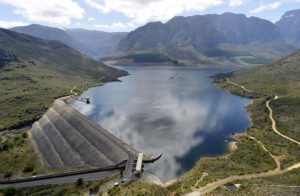Internet of Things being used to enable fish farming
Along the shores of East Africa’s Lake Victoria, in Kenya, women fisherfolk including those known for being victims of sexual exploitation are harnessing the Internet of Things (IoT) to help them counter their abusers while enhancing their incomes, writes Joseph Davis Weddi.
Fish trader and farmer Milly* told SciDev.Net how she used to offer her body to fishermen to obtain fish stocks at an affordable price to take to the market to sell, but she now breeds the tilapia herself and, thanks to digital technologies, she can bypass processes that expose her to bargaining with unscrupulous fishermen.
Along with other women who once traded their bodies to obtained fish, Milly co-owns floating cages in a digitally monitored fish farm on Lake Victoria.
Using their smart phones, the women can access information and receive notifications about the health of the fish they are rearing in the cages—and at the same time gain financial independence.
Not only are they countering the sexual exploitation, but they are working towards eradicating poverty in their homes—and improving food security—by taking direct ownership of the fish production process.
Fishermen catching wild fish on Lake Victoria have long exploited women fish traders.
“It was very difficult for me to get fish from the lake, because we have what is called: sex for fish,” says Milly, who used to sell silver fish at local markets.
“For you to get fish, without what we call ‘Jaboya’ [meaning customer], you can’t get the fish … you have to sell your body to get the fish … That is the big challenge.”
Kenya’s Rise to Shine Education Foundation says this degrading practice started due to dwindling fish populations on the lake resulting from overfishing and other environmental challenges which left business scrambling to get their catch. Vulnerable women and young girls, often under coercion, ended up agreeing to sex with the fishermen in order to secure their supply of fish to sell in local markets, according to the foundation.
Linah Velma, an official at Kisumu-based startup Aquarech Limited, which specialises in aquaculture technology and empowering women, explains: “Because of less fish stock in the lake … this puts our women fish traders in a very awkward position where they are forced to have sex [with the fishermen] to get fish.”
According to Velma, because Aquarech operates a business-to-business and business-to-consumer models and offers fish farmers a buy now, pay later solution for fish feed, women fisherfolk who have joined them have taken full advantage as they benefit from the free training and precision agriculture tools, such as digital technologies that help fish farmers learn about best practices and improve incomes.
In a focus group discussion organised by SciDev.Net, at Osoi beach in Migori country, women fisherfolk from various beaches in Migori said that owning fish cages, and using the internet to manage their fish farms, has freed them from Jaboya and poverty.
“We have seen that we are going to eradicate poverty because, when you have something at hand, you can go beyond,” said Angela Errie*, a discussion participant, noting that before starting fish farming, they relied on men as they the women lacked economic means. “The men used to have control of everything, even at home.
“Since we started the project, we have … [learnt] everything. After harvesting we shall continue and keep the money at the bank, without them [men] knowing what we have,” Errie added, and drew smiles and laughter from other women in the discussion.
“You can know the condition of the fish only through the machine that has been just introduced for measuring water temperature and seeing whether the water is fit for the fish to survive, says another discussant who did not want her name published.
These women have each opened multiple bank accounts which they access on their smart phones. They have been trained on how to use aquaculture technology, with IoT sensors to monitor the fish they are breeding in the cages on the lake, led by Rio Fish Limited – a social enterprise dedicated to empowering women and creating better environmental outcomes while connecting fish farmers to markets.
“We are going to do away with poverty within our community because now, we are about to harvest our fish, so we will have something in our hands. No one will take it away,” says another group member.
“Rio Fish introduced us to fish cage technology. Initially we did not know anything about that. Women never went to the lake to fish, it was the role played by men,” Quinta Habil*, said with a wide smile and concurred with the rest that they can now stand on their own economically.
Lake Victoria is Africa’s largest lake, and the world’s largest tropical lake with a surface area of almost 60,000 square kilometres. It is shared by Kenya, Uganda and Tanzania.
Every year, fisherfolk on the lake harvest one million tonnes of fish valued at US$300 million, according to Edward Rukuunya, a director at Lake Victoria Fisheries Organisation in Jinja, Uganda.
Cage fish farming is a highly significant development in aquaculture in East Africa according to the organisation, which recognises the multiple challenges affecting fisheries production and the livelihoods of the lake communities which depend on it.
As well as COVID-19 and flooding, the industry has been beset by among the fisher communities along the value chain, as well as HIV/AIDS and waterborne diseases such as bilharzia, according to its fisheries management plan.
Rukuunya says around 200,000 people are directly engaged in fishing across the Lake Victoria basin, while 700,000 are engaged in the fisheries value chain.
However, women play a big role in the post-harvest handling of fish, known as artisanal fish processing, where they constitute more than 60 per cent of those employed.
“Women are the backbone within the fishing communities,” says Rukuunya.
“They labour a lot to get fish to feed the children, hence improving on nutrition. They labour a lot through their earning to pay [children’s school] fees… with the little earnings, they manage to pay hospital bills.
“Overall, they contribute to reducing poverty, improving health of the children and people within the fishing communities, hence contributing to the Sustainable Development Goals,” he adds.
Lake Victoria’s fishing industry has traditionally been controlled by men who owned the tools needed to catch wild fish. However, with the introduction of IoT and related digital technologies, notably mobile apps, the tables are starting to turn in favour of women in the fisheries value chain. More women are practicing cage fish farming as opposed to the labour-intensive wild fish catch on the lake.
Digitalisation in the fisheries value chain around Lake Victoria starts with a sensor that is placed in fish ponds or fish cages. The technology provides information and alerts that empower women fish traders to by-pass likely exploiters.
In Migori, Kenya, where Milly and her fellow women fisher folk operate, the sensors used in their fish cages provide information on lake water temperature, which is sent to a central platform and results in recommendations including when to feed the caged fish or when to restock stores of fish feed. Fish feed suppliers also receive notifications telling them which fish farmers will soon need to be supplied.
Fish farmers also input information on the growth of their fish which can be monitored by traders to inform them which farm is ready to harvest and the average size of the fish.
On the Kenyan side of Lake Victoria, beach management unit leaders in Mbita and Ogal beaches are encouraging more cage fish farming among local communities.
“Women are now very involved in cage fish farming,” says Moses Owino, who manages the fisheries on Ogal beach. “For them to own a cage does not require anything. They just come to the BMU [beach management unit], apply, and automatically we will give them a chance. So, they are very much involved as opposed to our normal fishing which needs a lot of manpower.”
He says there are more than 60 women practicing cage fish farming from the Ogal beach and using sensors to monitor their fish.
As a result, the Jaboya practice has diminished in his area, says Owino.
When harvest is due, fish traders use the app to place orders for fish and ice used to preserve it before and during transportation to market.
In Mbita town, a popular landing site for the wild fish catch, Irene Onyango, the operations assistant for Nairobi-based company Keep It Cool, explains that women fish traders have some challenges competing with their male counterparts and are hampered by a lack of funds.
But women are beginning to overcome these difficulties, according to Morris Muma, chairman of Mbita beach management unit, which has more than 60 women fish farmers.
“We have seen great changes in women,” he says. “We have seen them having groups. They have bought their own vehicles. They have bought some farms using proceeds from fish farming. They have built homes.”
He says the practice of Jaboya has been expunged.
Muma acknowledge that this transition has not been without its problems, however, including fish perishing in the cages. He believes that women fish farmers need more education on how to use the IoT technology.
According to a survey by Dalberg, by November 2020, 98 per cent of Kenyans over the age of 15 owned a mobile phone SIM, 65 per cent had access to the internet, and 52 per cent owned a smartphone, while mobile money had achieved 94 per cent adoption.
This means women fisherfolk are able to make full use of available digital technologies.
Various organisations and social enterprises have taken interest in empowering women fisherfolk along the shores of Lake Victoria and have come up with technology solutions to support them. Two of the most widely used apps that have been developed are the Rio Fish App and the Aquarech app.
“We are training [women] on the best aquaculture practices, we are training them on stocking capacity where they are told the number of fish they are supposed to put in their cages, how they are supposed to manage things throughout the production cycle, which should take a maximum of eight months,” says Velma of Aquarech.
At harvest, the farmers supported by Aquarech can sell their fish to the company, which then completes the rest of the value chain including delivery of the fish to markets, hotels and street food vendors.
Aquarech had to replace all their equipment used on the lake following reports that the sensors were not working, and that fish were dying.
However, Velma, who helped apply the new sensors, says everything is now working and the farmers have undergone refresher training.
Through its app, Aquarech has seen an increase of fish traders from 250 to 3,859, among whom are 1,326 women. The company achieved this after receiving a grant from the to test and scale a pilot project of IoT devices for fish farmers in 2022.
They also raised US$1.7 million in equity funding to hire talent, acquire more feed and set up infrastructure to support integration of the IoT technology. In the past two months, they have received further funding towards the work they are doing around Lake Victoria.
Ben Roberts, chief technology officer at Liquid Intelligent Technologies, says his company is helping in designing the technology behind the IoT sensors and these are fully built in Kenya.
On Lake Victoria, fluctuating water temperatures due to climate change make it difficult for fish farmers to know when and how much to feed their stock. According to AquaRech, fish are sensitive to water temperature and only eat when the temperature is within a certain range. For that reason, the IoT sensors are deployed to help gather data that will be used to advise when best to feed the fish and even when best to harvest.
Roberts says Liquid Intelligent Technologies partners with startups in the space of agriculture and aquaculture technology, including AquaRech who are championing cage fish farming.
“A lot of these people doing fishing [from the cages] are women and they have had trouble with access to markets,” he says.
“By using digital technology, mobile apps, [this] is helping them get access to markets. The IoT technology is helping them improve their yields.”
In the city of Kisumu, Josephine Odongo manages AquaRech’s Fish Deli – a new fast food kiosk that is changing the way customers order fried fish. Equipped with commercial air fryer for preparing the fish, Odongo’s kiosk also has access to the AquaRech App through which she regularly orders fresh fish to restock her deep freezer.
She takes orders via her smartphone and enters her accounts into an online system, taking payments via a local mobile phone payment platform, mPesa.
She says she feels empowered by these technologies, and that no one can just “walk over her”.
“I have my money. I take care of myself … I look after my five kids. I can buy food in the house. I help my partner with some bills and he is happy,” she explains, adding that it all starts with cage fish farming where IoT sensors are being used to monitor the growing fish.
This piece was produced by SciDev.Net’s Global edition desk.
* SciDev.Net has changed the names of selected women to protect their identities.
The post Internet of Things being used to enable fish farming first appeared on KBC.




